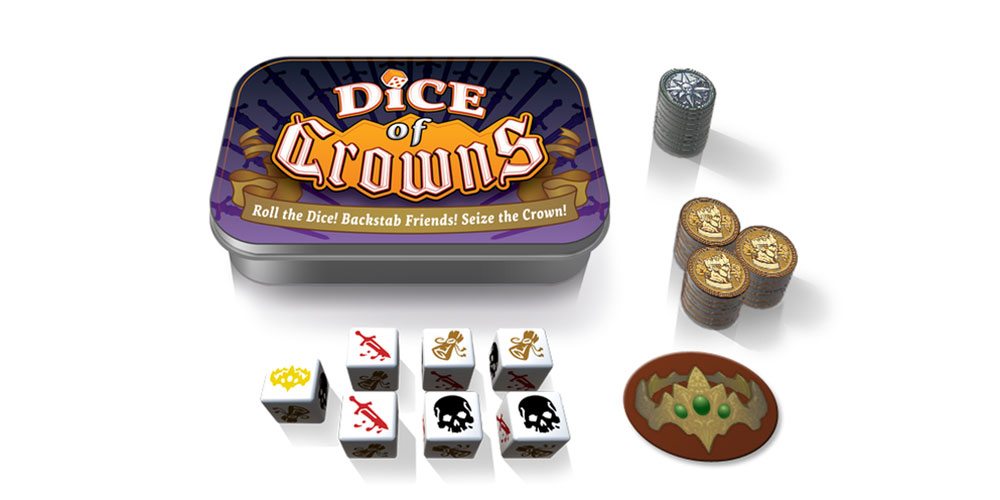
The king is dead, so of course it’s time to fight over the crown. Some have rightful claims to the crown; others have acquired influence through twists of fate. But beware: betrayal from within your own house could be your downfall.
At a glance: Dice of Crowns is a dice game for 2 to 6 players and takes about 10–20 minutes to play. It’s currently seeking funding on Kickstarter, with a $10 pledge for a copy of the game. The game is a light press-your-luck game with a bit of backstabbing, so I think it’s fine for ages 8 and up as long as long as players don’t take betrayals personally.
New to Kickstarter? Check out our crowdfunding primer.

Components:
- 7 custom dice
- Claim tokens
- Fate tokens
- 1 Crown
The prototype I tried used 3D-printed parts, so the final product will vary, but the component count should be similar. It does look like the final will still be in a little mint tin case, though, making it pocket-sized and great for travel. (Just don’t lose those tokens!)
The dice are six-sided, and each one has the following faces: 1 Crown, 1 Dagger, 2 Skulls, and 2 Scrolls.
The plastic crown is pretty cool, actually—it’s only used with the Last Stand rule, but I hope it turns out like the prototype. It looks like a storybook king’s crown, and is just about big enough around to fit on my thumb. Right now it looks like the final game will include a crown token, but the first stretch goal is to upgrade to a 3D plastic crown instead.

How to Play
There are two versions, Quick Play and Advanced Play. I’ll explain Quick Play first, and then Advanced Play below.
Quick Play
The goal of the game is to secure the crown by acquiring 3 Claim tokens.
Players take turns as the active player. When you’re the active player, you roll all of the dice available to you (sometimes that’s not all of them).
Crowns represent a rightful claim to the throne: if you roll 3, take a Claim token; 7, you take 2 Claim tokens.
Skulls represent the whims of fate: if you roll 5, take a Claim token; 7, you take 2 Claim tokens.
Daggers represent betrayal: if you roll 3 or more, your turn ends and you get no Claim tokens, even if you had enough Crowns otherwise. If you roll 7 Daggers, it’s the Grand Betrayal: give a Dagger die to every player.
Scrolls are Intrigue: Give each Scroll to a player of your choice. That player must immediately roll and resolve it:
- Crown: The rolling player keeps the Crown for their next turn.
- Dagger: The rolling player gives the Dagger to the player of their choice.
- Skull or Crown: The die is returned to the active player.
After scrolls are rolled and returned, the active player may claim a token if possible, or re-roll all Skulls, Scrolls, or both. (You may not re-roll only some of your Skulls, for instance.) The turn continues as above until the player has claimed a token, rolled 3 or more Daggers, or it is no longer possible to claim a token because of the number of dice remaining.
As soon as a player has 3 Claim tokens, they claim the crown and win!
Advanced Play
The goal of the game is to acquire 5 Claim tokens.
Most of the rules are the same as Quick Play. However, if you roll 3 Skulls, you may claim a Fate token instead of trying to get 5 Skulls for a Claim token. (Again, your turn ends as soon as you claim a token of any sort.) Fate tokens may be spent for re-rolls: 1 token to re-roll any one of your dice (before it takes effect); 2 tokens to force a re-roll of any one die on the table at any time during the game; 3 tokens to force a re-roll of all dice on the table at any time.
When using the 3 token re-roll:
- Skulls return to the active player.
- Crowns and Daggers stay with the player who rolled them.
- Scrolls are passed to other players, at the choice of the player who rolled them.
The other new rule in Advanced Play is that if the active player rolls 4 or more Daggers, they keep 3 of them but any others are given to rivals of their choice. (The Grand Betrayal still trumps this, giving 1 Dagger to each player.)
Last Stand
Finally, you can add the optional Last Stand rule to Advanced Play. When you claim your 5th token, take the Crown instead. To win, you must keep the Crown for a full round of play. Any player who claims a 5th Claim token during that round steals the Crown from you (and must hold onto it for a round). Any player who rolls 7 Crowns or 7 Skulls steals the Crown, regardless of token count.
If you hold the Crown for an entire round until the end of your turn, you win. If you roll 3 or more Daggers durin your turn, you do not win and play continues for another round.
The Verdict
Dice of Crowns is a fun, quick dice game with a lot of “take that” thrown into it. It’s a fairly light game, comparable to something like King’s Gold, though there are player decisions that add a little more depth to it. I would say it makes a nice palate-cleanser between heavier fare, but isn’t something you’d spend an entire game night on.
What Dice of Crowns adds to your usual press-your-luck dice game is a chance to roll dice when it’s not your turn. The active player must give Scrolls to other players, and then they get a chance to roll. I like the fact that if you roll a Crown, you get to keep it for your turn, and if you roll a Dagger, you get to choose the player who gets it. In many cases, it makes sense to give it to somebody other than the active player, because it’s already removing a die from the active player’s pool (making it less likely that they’ll achieve the requirements for a Claim token) but can also effectively remove a die from another player’s upcoming turn. Sometimes the choice can be fairly obvious, but there’s a catch, too: if you give it to a player whose turn will come after yours, then you’ll be short a die on your own turn.
The dice redistribution also means that, in many cases, you won’t roll all 7 dice as active player. I’ve never seen anyone roll a 7-of-a-kind, and in most cases, it was impossible to begin with. Usually you’re deciding between trying for 3 Crowns or 5 Skulls.
I do like the Advanced Play rules with the Fate tokens, because it adds another decision that actually has consequences. If you have 3 Skulls already, you have to balance the chance to get a Claim token with the guaranteed Fate token. But collecting a Fate token ends your turn, so if other players are snapping up Claim tokens, you may be wasting a valuable turn when you stop early. Of course, if you get 3 Daggers, then you get nothing at all. In one turn, I spent 2 Fate tokens, one at a time, re-rolling a Dagger to try to keep myself from busting … and rolled a Dagger two more times. So a Fate token isn’t a guarantee.
Collecting more Fate tokens, though, can be a lot of fun, when you can force other players to re-roll. You could use it to try to retrieve a Crown that another player rolled with one of your Scrolls. Or you could force the active player to re-roll a Crown, hoping to get them to bust instead. Saving up Fate tokens for a crucial moment can be the key to victory.
Even the Advanced Play rules are fairly simple—the whole rulebook fits on a small sheet of paper—so unless you’re playing with inexperienced gamers, you can probably skip ahead to Advanced Play either immediately or after one round. It adds a little more strategy without making the game that much more difficult.
If you like little dice games but you’re tired of Zombie Dice and Yahtzee, you might enjoy Dice of Crowns. The Scrolls add a layer of player interaction that’s missing in many dice games. For more information, visit the Dice of Crowns Kickstarter page.
Disclosure: I received a demo prototype for review.


